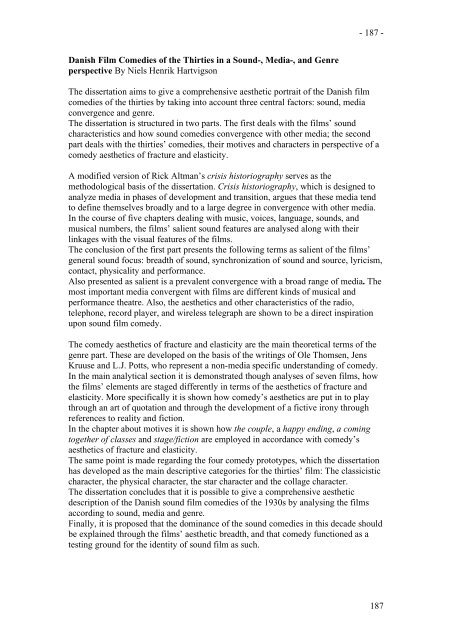1930'ernes danske filmkomedie i et lyd-, medie- og genreperspektiv ...
1930'ernes danske filmkomedie i et lyd-, medie- og genreperspektiv ...
1930'ernes danske filmkomedie i et lyd-, medie- og genreperspektiv ...
Create successful ePaper yourself
Turn your PDF publications into a flip-book with our unique Google optimized e-Paper software.
Danish Film Co<strong>medie</strong>s of the Thirties in a Sound-, Media-, and Genre<br />
perspective By Niels Henrik Hartvigson<br />
- 187 -<br />
The dissertation aims to give a comprehensive aesth<strong>et</strong>ic portrait of the Danish film<br />
co<strong>medie</strong>s of the thirties by taking into account three central factors: sound, media<br />
convergence and genre.<br />
The dissertation is structured in two parts. The first deals with the films’ sound<br />
characteristics and how sound co<strong>medie</strong>s convergence with other media; the second<br />
part deals with the thirties’ co<strong>medie</strong>s, their motives and characters in perspective of a<br />
comedy aesth<strong>et</strong>ics of fracture and elasticity.<br />
A modified version of Rick Altman’s crisis histori<strong>og</strong>raphy serves as the<br />
m<strong>et</strong>hodol<strong>og</strong>ical basis of the dissertation. Crisis histori<strong>og</strong>raphy, which is designed to<br />
analyze media in phases of development and transition, argues that these media tend<br />
to define themselves broadly and to a large degree in convergence with other media.<br />
In the course of five chapters dealing with music, voices, language, sounds, and<br />
musical numbers, the films’ salient sound features are analysed along with their<br />
linkages with the visual features of the films.<br />
The conclusion of the first part presents the following terms as salient of the films’<br />
general sound focus: breadth of sound, synchronization of sound and source, lyricism,<br />
contact, physicality and performance.<br />
Also presented as salient is a prevalent convergence with a broad range of media. The<br />
most important media convergent with films are different kinds of musical and<br />
performance theatre. Also, the aesth<strong>et</strong>ics and other characteristics of the radio,<br />
telephone, record player, and wireless telegraph are shown to be a direct inspiration<br />
upon sound film comedy.<br />
The comedy aesth<strong>et</strong>ics of fracture and elasticity are the main theor<strong>et</strong>ical terms of the<br />
genre part. These are developed on the basis of the writings of Ole Thomsen, Jens<br />
Kruuse and L.J. Potts, who represent a non-media specific understanding of comedy.<br />
In the main analytical section it is demonstrated though analyses of seven films, how<br />
the films’ elements are staged differently in terms of the aesth<strong>et</strong>ics of fracture and<br />
elasticity. More specifically it is shown how comedy’s aesth<strong>et</strong>ics are put in to play<br />
through an art of quotation and through the development of a fictive irony through<br />
references to reality and fiction.<br />
In the chapter about motives it is shown how the couple, a happy ending, a coming<br />
t<strong>og</strong><strong>et</strong>her of classes and stage/fiction are employed in accordance with comedy’s<br />
aesth<strong>et</strong>ics of fracture and elasticity.<br />
The same point is made regarding the four comedy prototypes, which the dissertation<br />
has developed as the main descriptive categories for the thirties’ film: The classicistic<br />
character, the physical character, the star character and the collage character.<br />
The dissertation concludes that it is possible to give a comprehensive aesth<strong>et</strong>ic<br />
description of the Danish sound film co<strong>medie</strong>s of the 1930s by analysing the films<br />
according to sound, media and genre.<br />
Finally, it is proposed that the dominance of the sound co<strong>medie</strong>s in this decade should<br />
be explained through the films’ aesth<strong>et</strong>ic breadth, and that comedy functioned as a<br />
testing ground for the identity of sound film as such.<br />
187
















